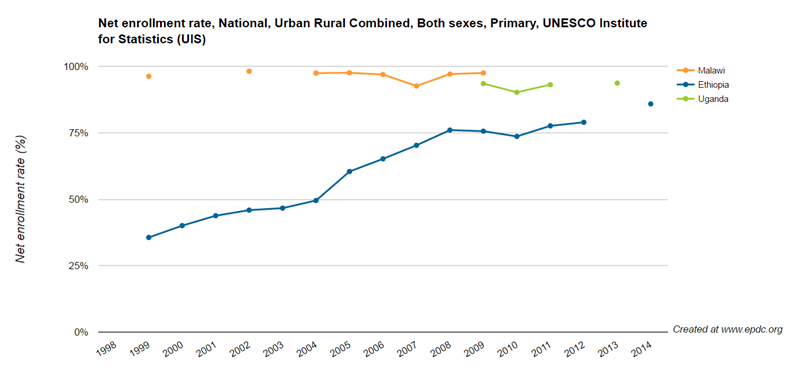You are here
Making the Case for Universal Primary Education
Hibatalla Ibrahim, Research Intern
The United Nation’s second Millennium Development Goal of achieving Universal Primary Education (UPE) has come to an end in 2015. Though the world missed this target by more than 59 million out-of-school children of primary school-age (UNESCO, 2015), remarkable strides have been made towards ensuring children are able to complete a full course of primary schooling. These accomplishments have been particularly exceptional in sub-Saharan Africa, with enrollment rates rapidly rising from 52% in 1990 to 80% in 2015 (UNESCO Institute for Statistics, 2011). But the question remains: Was Universal Primary Education successful?
To date, there has been no systematic analysis of the causal impact of free primary education policies that were implemented in the 1990s across sub-Saharan Africa. Fortunately, enough time has passed since the policy’s implementation and many of the beneficiaries of these policies - primary-aged children at the time - are now adults in their early to late twenties and thus, their current educational attainment, labor market participation and health outcomes will be useful in assessing the effects of Universal Primary Education. The hypothesis is that individuals who were young enough to benefit from the policy should have higher education, labor market and health outcomes than older individuals unaffected by UPE.
It was with this in mind that FHI 360’s Education Policy and Data Center set about to explore two questions:
- What is the effect of Universal Primary Education on educational attainment and gender equity in education?
- And in turn, what is the effect of years of schooling on labor market and health outcomes?
To investigate these questions, FHI 360 is utilizing nationally representative data from Demographic and Health Surveys (DHS) and Living Standards Measurement Study (LSMS) household surveys. EPDC is examining a host of demographic, education, labor market and health indicators such as gender, years of schooling, salaried employment, smoking, HIV/AIDS and age at first marriage/cohabitation.
The countries included in the analysis are Ethiopia, Malawi and Uganda as they were among the first countries in sub-Saharan Africa to adopt Universal Primary Education. Abolishment of primary school fees was introduced in 1994 in Ethiopia and Malawi under the Education and Training Policy and Free Primary Education Decree, respectively, and in 1997 in Uganda under the Universal Primary Education policy.
Figure 1 - Net enrollment rates
Figure: Growth in primary net enrollment rates in Ethiopia, Malawi and Uganda for both sexes and urban/rural areas combined. Source: UNESCO Institute for Statistics (UIS).
EPDC is exploiting the dramatic change in policy in 1994 for Ethiopia and Malawi and in 1997 for Uganda. Universal Primary Education is endogenous and children affected by the program do not have the ability to self-select into it; hence, the policy can be viewed as a natural experiment. Under this assumption, the analysis of data is carried out in two stages: the first is to analyze the causal effect of UPE on educational attainment and the second is to look at the impact of that additional educational attainment on labor market and health outcomes.
Although Universal Primary Education is regarded to be among the most ambitious and widely implemented social policies in recent times, there exists little research on its causal impact. EPDC’s findings will prove valuable for policy makers across sub-Saharan Africa; learning about what worked (and what did not) offers valuable lessons in moving towards universal secondary education in the future. The findings, which will be published in a future post, will not only reveal insights about educational attainment and gender equity in education but also whether that would translate to higher income and health levels.
Links:


Add new comment